World NTD Day 2024: Early Career Grant Research into NTDs
To mark World NTD Day 2024, we spoke to a number of our Early Career Grant awardees about what this year’s theme of ‘Unite, Act, Eliminate’ means to them and why they chose to focus on NTDs in their Early Career Grant research.
Veronique Koffi
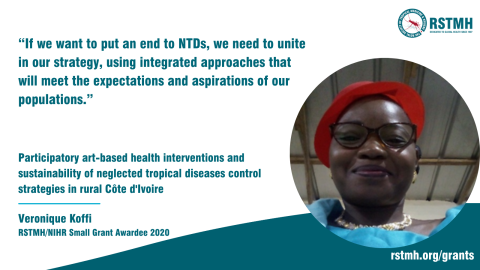
If we want to put an end to NTDs, we need to unite in our strategy, using integrated approaches that will meet the expectations and aspirations of our populations. We must also take into account the social dimension of an integrated approach. Fight NTDs is global health and development success story.
I have chosen this area of research “participatory art-based health interventions and sustainability of neglected tropical diseases control strategies in rural Cote d’Ivoire” because, in Côte d’Ivoire, studies have demonstrated that observable efforts have been made by the government and its partners against NTDs. Those efforts being jeopardized by the absence of participatory community-based programmes. The project consisted of developing health education awareness-raising tools such as participatory theatre and cartoons. However, we assessed the impact of the activities carried out on behavior of populations regarding hygiene and sanitation through photos.
Bernard Raymond Kihumuro
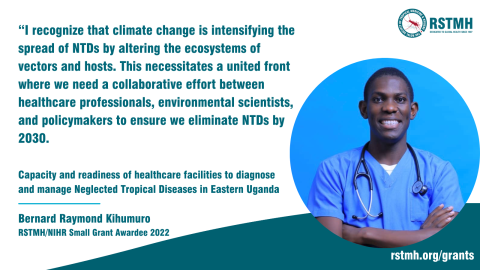
In my research on the 'Capacity and readiness of healthcare facilities to diagnose and manage Neglected Tropical Diseases (NTDs) in Eastern Uganda', I am deeply aware of the urgency of the theme 'Unite, Act, Eliminate', especially in the context of climate change. I recognize that climate change is intensifying the spread of NTDs by altering the ecosystems of vectors and hosts. This necessitates a united front where we need a collaborative effort between healthcare professionals, environmental scientists, and policymakers to ensure we eliminate NTDs by 2030. There is need to strengthen capacity at healthcare facilities while also revamping public health strategies to have a successful fight. Most importantly we need to integrate the aspect of climate change in all our efforts. With these in place I am certain we shall be able to eliminate NTDs.
Why have you chosen your area of research?
In my research on the 'Capacity and readiness of healthcare facilities to diagnose and manage Neglected Tropical Diseases (NTDs) in Eastern Uganda', I focused on understanding the readiness of primary healthcare facilities, a crucial baseline for tracking progress towards eliminating NTDs by 2030. Despite the World Health Organization's endorsement, the actual integration of NTDs into Uganda's healthcare systems has been largely unexplored, with significant research gaps in healthcare workers' knowledge and resource availability. My study aimed to assess the readiness and capabilities of healthcare facilities in Eastern Uganda, evaluating health workers' knowledge, diagnostic tools, medications, and reporting systems. The goal was to inform policy and develop more effective measures to combat NTDs, contributing significantly to national and global elimination efforts.
Dirghayu K.C

As a public health researcher, I was well aware of NTDs being sidelined during the pandemic. Owing to which, supply chain assessment of NTDs; drugs, and diagnostics, was certain to identify the shortcomings and loopholes existed in our newly adopted devolved system and generate evidence as well as policy recommendations in order to achieve better outreach and eliminate NTDs as a whole.
United, and efficient system-better outreach-swift NTD eradication.
Joseph Nelson Siewe

As we look forward to eliminating onchocerciasis before the next decade, it is expedient that we unite our efforts – at the community, national, and international levels – to make meaningful progress. Communities must adhere to mass drug administration with ivermectin so as to kill the parasite in all individuals in at-risk villages. Furthermore, alternative strategies such as the “Slash and Clear” vector control approach against blackflies rely on community ownership for uptake and sustainability. National onchocerciasis programs are called upon to strategize their interventions, by prioritizing areas with the highest burden of disease including the devastating onchocerciasis-associated epilepsy and nodding syndrome. Finally, on the international scene, advocacy should be amplified for stakeholders to move NTDs up on the international agenda which would motivate more attention and funding to eradicate these diseases.
Why have you chosen your area of research?
In view of the persistent transmission of onchocerciasis despite two decades of ivermectin mass drug administration in Cameroon, it became clear that alternative strategies were needed to achieve elimination. Previous vector control approaches made use of chemical larvicides with serious economic and environmental repercussions. I chose the “Slash and Clear” approach as it is a relatively cheap, community-owned and environmentally friendly strategy to destroy blackfly breeding sites, thereby accelerating onchocerciasis elimination. My research project confirmed that this approach is well accepted by the local community and feasible to the extent of accessibility of the breeding sites in a given onchocerciasis focus. Therefore, it has the potential to be scaled up across Cameroon and other endemic countries.
Junior Mudji

We have been really successful in raising the NTD profile and providing preventive and curative chemotherapy to billions. In Vanga region of DRC, Human Trypanosomiasis was a serious problem, the number of cases has dropped but we are afraid of a resurgence as the challenge of adequate surveillance and diagnosis remains and because the new generation medical doctors with a knowledge of HAT treatment is limited. Onchocerciasis and lymphatic filariasis are still endemic, but numbers have fallen. We must also embrace the “leave no-one behind” concept. Those with chronic often incurable disability are often still neglected- HAT is a case in point but there are other disabilities-irreversible blindness, snake bite sequelae, skin lesions from leishmaniasis etc.
Why have you chosen your area of research?
I’m a clinician in Vanga hospital, DR Congo and my daily work is to see patients in the hospital and sometimes travel and talk with patients in their home villages. I observed that some former patients treated for Human Africa Trypanosomiasis several years before, complained about symptoms like headache, insomnia, and anxiety. For some, family members reported persistent behaviour change. I also discovered that some patients who had been treated shortly after birth as a result of congenital transmission and remained parasite free were affected by irreversible and severe neurologic disabilities as a result of congenital HAT . I discussed with my 2 mentors, Prof David Molyneux and Prof Johannes Blum who encouraged me to work on the mental health and neurological sequelae of former treated patients.
Kedir Geda Bamedo

In the face of Neglected Tropical diseases, solidarity is our greatest strength. Together, we can unite to ensure a world free from the burden of Rabies disease. Every step we take towards eliminating Neglected Tropical diseases is an act of defense against the injustices these diseases bring. We must unite and act to create a brighter, more prosperous, and healthier future. It is time to break the chains of Neglected Tropical Diseases. Unite, Act, and Eliminate. Unite in knowledge, Act with compassion, and together, we will eliminate the burden of Neglected Tropical Diseases including Rabies, ensuring a better life for generations to come.
Why have you chosen your area of research?
Rabies is one of the most lethal infectious diseases with an almost 100% fatality rate. It remains a significant public health problem mostly affecting low- and middle-income countries (LMICs). Ethiopia is one of the most rabies-endemic countries in the world, and it has the 2nd highest human death rate in Africa where 46% of rabies cases are found in the Oromia region. Timely access to human rabies post-exposure prophylaxis (PEP) is a challenge in health facilities particularly at the health center level that poses a threat to the WHO Neglected Tropical Diseases (NTDs) elimination goal. As a Field epidemiologist, I have always been very excited to study the NTDs that pose significant public health problems in our communities including rabies diseases. My interest focuses on barriers to human rabies availability and accessibility for animal bite victim individuals’ I studied the socioeconomic and healthcare facility barriers using facility-based stud. My ultimate goal is to help improve PEP vaccine supply chain management to ensure consistent, planning, forecasting, and distribution of health in facilities, to develop innovative delivery approaches and policies to ensure timely access to PEP for rabies elimination.
Nwdawula Junior Charles

Vectors are blood-sucking organisms capable of transmitting animal-human infectious pathogens ranging from: bacteria, nematodes, fungi, protozoa and viruses; hence emerging/re-emerging epidemic global disease outbreaks. Therefore, control of re-emerging disease outbreaks calls for a “Unite-Act-Elimination” strategy which entails: (1) “Uniting” by constituting teams with diverse professional expertise (One Health) to foster understanding the disease etiological/vector-pathogen transmission dynamics. (2) “Acting” by Developing sustainable solutions for disease outbreak control based on the established knowledge about the vector-pathogen transmission dynamics. (3) “Elimination” by Field application of developed outbreak disease control measures. Our research project explores the “unite phase” fostering the search for sustainable ways of Nodding disease control.
Why have you chosen your area of research?
The rationale for pursuing research on ‘Demystifying the aetiological role of livestock and blood-sucking-vectors in nodding syndrome’ is: the lack of understanding of the cause of nodding disease despite wide exploration of nodding disease-affected humans while yet ignoring the animal-vector-human interaction.
Syafiq Asnawi

My research focuses on studying snake venom properties and advancing antivenom research. The theme of World Neglected Tropical Diseases (NTD) Day aligns closely with my work, emphasizing the importance of a unified goal and decisive action. By uniting our efforts, we aim to significantly reduce and ultimately eliminate the burden of snakebite envenomation, addressing a critical aspect of Neglected Tropical Diseases
Why have you chosen your area of research?
Mass spectrometry enables the thorough identification of proteins found in snake venoms. This is accomplished by examining the mass and peptide sequences of these proteins, allowing for the recognition of a diverse range of venom components. Through the utilization of cutting-edge mass spectrometry technology and proteomic studies, our goal is to create a versatile antivenom capable of offering broad-spectrum protection against various venomous species
Emmanuel Siddig

I am committed to researching neglected tropical diseases because I believe in the fundamental right of every person to access health and opportunity. By addressing NTDs, we can work towards building a more equitable world where all individuals have the chance to thrive and live healthy, fulfilling lives.
Why have you chosen your area of research?
I have chosen to focus on the diagnostic accuracy of a novel multiplex PCR assay for rapid identification of eumycetoma causative organisms because I am passionate about accelerating the diagnosis and treatment of this debilitating condition. By improving diagnostic capabilities, we can positively impact patient outcomes and contribute to the global effort in combating eumycetoma.
Anifowose Samuel
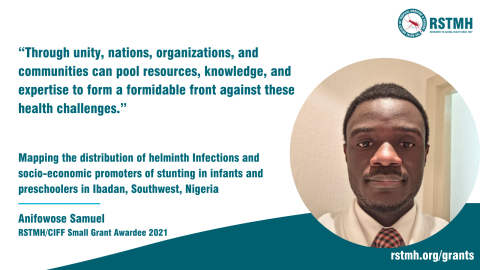
Unite, Act, Eliminate" serves as a robust rallying cry in the collective effort to combat tropical diseases in Africa and across the globe. Through unity, nations, organizations, and communities can pool resources, knowledge, and expertise to form a formidable front against these health challenges. Taking decisive action is paramount, involving coordinated strategies for prevention, diagnosis, and treatment. From my research, leveraging a united front and implementing proactive measures was done towards eliminating the burden of tropical diseases in Africa and especially Nigeria, paving the way for healthier, more resilient communities. This theme encapsulates the spirit of collaboration and determination needed to overcome the complex health issues facing the local and international communities.
Why have you chosen your area of research?
The research topic, "Mapping the distribution of helminth infections and socio-economic promoters of stunting in infants and preschoolers in Ibadan, Southwest, Nigeria," addresses a critical intersection of health and socio-economic factors. By investigating the prevalence and distribution of helminth infections, the study aims to provide valuable insights into the geographical spread of these parasitic infections. Additionally, the focus on socio-economic promoters of stunting recognizes the multifaceted nature of child health, linking it to broader societal and economic determinants. Hence, choosing this research is poised to contribute significantly to public health initiatives by guiding targeted interventions that not only address the immediate health concerns but also consider the underlying socio-economic factors influencing child development in the specific context of Ibadan, Southwest, Nigeria.
Joseph Baluku

This year's theme is a battle cry for communities, scientists, and world leaders to rally around the NTD banner. When you come to think of it, these are not merely Neglected Tropical Diseases, these are Neglected People. Helminths curtail millions of people from achieving their full life potential. There is a moral imperative that we eliminate helminths.
Why have you chosen your area of research?
I chose to study helminths and CVD to advance our understanding of the role of helminths in modulating CVD risk. TB patients and TB survivors face significant CVD risk. We hoped we could learn how helminths modify the prevalence of CVD risk factors in this vulnerable population.
Vincent Pam

As the saying goes “United we stand divided we fall” so is the case with the fight to eliminate NTDs. Governments, Scientists/Researchers and the affected communities must all work together to achieve the set goal.
Female Genital Schistosomiasis (FGS) affects an estimated 56 million girls and women, but shockingly gaps still exist in the epidemiological assessment and burden particularly in Nigeria. Therefore I investigated the disease to see if there is an association with cervical cancer.
Moses Samje

“Cognizance of the increased suffering caused by co-morbidities of NTDs and non-communicable diseases, a cohesive and global response that emphasizes collaboration, decisive action and a collective fight for eradication is imperative. Therefore, by fostering unity among nations, mobilizing proactive measures, and committing to elimination strategies, the cycle of suffering can be broken, thereby promoting health and prosperity for the millions affected by these diseases. Let us unite, act, and eliminate NTDs now!”
Paul Tsaku
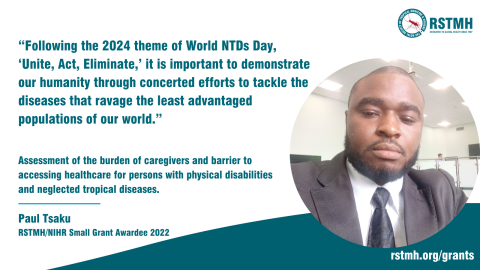
Neglected Tropical Diseases are a group of diseases that mostly impact the poorest of the poor, especially those living in low-income countries. Following the 2024 theme of World NTDs Day, “Unite, Act, Eliminate,” it is important to demonstrate our humanity through concerted efforts to tackle the diseases that ravage the least advantaged populations of our world.
I am passionate about fighting the so-called ‘diseases of poverty’ having experienced how dreadful it can be. That inspired my interest in researching NTDs. Thanks to the research grant from RSTMH/NIHR I am currently working on a study titled “Assessment of the burden of caregivers and barriers to accessing healthcare for persons with physical disabilities and NTDs.” The study aims to understand the challenges of NTDs not only from the perspective of the persons with lived experience but also to unravel its impact on close relatives and to understand how supporting the caregivers can improve the expected outcomes of combating NTDs.
Stella Nanyonga

By uniting our efforts as health workers, we can create a world where no one suffers needlessly from snakebites. Our collective focus should be on making proven and efficacious snakebite treatments readily available, particularly to the most vulnerable populations. By joining forces, we can significantly contribute to reducing the burden of snakebite-related morbidity and mortality.
Why have you chosen your area of research?
My motivation for this research was to understand the patterns of snakebite treatment and associated treatment outcomes which is crucial for developing targeted medical responses to snake bites and identifying areas for improvement when managing snakebite envenomation.
Precious Azubuike

Buruli Ulcer Disease (BUD)has received less attention than it should have in the last couple of years and little research has been carried out on BUD, despite its debilitating and stigmatizing impacts. There is an urgent need to involve all stakeholders and key actors – employing an intersectoral and interdisciplinary approach towards generating evidence that informs programmes and interventions toward eliminating BUD as well as other NTDs in Nigeria, Africa, and globally!
Why have you chosen your area of research?
Although BUD is the third most prevalent mycobacterial illness in humans, after tuberculosis and leprosy, information is scarce in Nigeria about its epidemiology, management, and outcomes. Some outcomes resulting from the treatment and management of BUD include impacts on the physical and mental health of patients, patients’ belief that they are burdensome to their families and caregivers, and their inability to fully reintegrate into society due to the stigma and discrimination they face. My study seeks to generate evidence on lived experiences and psychosocial implications on BUD patients and convalescents to inform programmes that incorporate psychosocial management and follow-up of BUD patients and convalescents.
Jonathan Steinhorst

Successfully reducing the global burden of snakebite envenoming is a multidisciplinary effort requiring collaboration by a diverse range of professionals, ranging from epidemiologists, medical doctors, biologists, zoologists all the way to politicians. It’s not only the different disciplines that must unite, but also different stakeholders (e.g., NGOs, governments, pharmaceutical companies, private businesses) and countries spread far across the globe. By uniting, the utility of limited research and public health resources can be pooled and their utility maximized in an ‘economies of scale’ fashion. The same networks can be used to channel innovations and solutions back to the countries and people in need of them. While snakebite envenoming as an NTD will likely never be entirely eliminated, a number of risk factors that predispose certain populations to dangerous snake encounters can be eliminated or at least reduced. What’s more, improving the efficacy and delivery of therapeutic measures can significantly reduce snakebite associated morbidity and mortality.
By uniting and acting, the status of snakebite as a neglected tropical disease can be eliminated.
Why have you chosen your area of research?
With support of the RSTMH early career grant, I have chosen to study the side effects of snake antivenoms. While antivenoms have proven their merit in saving lives, they have often been associated with side effects and even anaphylactic shock. Such reactions can be dangerous, particularly in an already envenomed patient. The cure should not be worse than the disease. But where is the boundary between cure and disease? Which symptoms are related to the effects of snake venom? And which symptoms are caused by antivenom? And are those symptoms due to anaphylaxis, as is commonly thought? To address this question, we want to study blood samples of patients experiencing side effects after receiving antivenom and see if they contain elevated levels of a marker that is indicative of anaphylactic reactions.
Khyathi Reddy

The theme 'Unite, Act, Eliminate' encompasses the pressing need for a collaborative effort to overcome the stigma and challenges associated with leprosy and its related disabilities. The theme emphasizes the importance of bringing together all relevant stakeholders, including healthcare professionals, the government, NGOs, and affected communities, to work in harmony towards a common goal of ending leprosy, disabilities, and discrimination. By doing so, we can break down the barriers that prevent access to care and support, and ultimately create a world where people affected by leprosy can lead full and healthy lives.
Why have you chosen your area of research?
The selection of my research area stems from the pressing need to address the overlooked aspect of oral health among people affected by leprosy. They have the double burden of disability and stigma which hinders them from maintaining their oral hygiene and seeking proper timely oral care. The study findings helped me generate evidence on the oral health needs of people affected by leprosy-related disabilities with the aim of improving healthcare strategies and fostering inclusivity in oral health initiatives.
Hassan Alaka

To achieve universal health coverage, it is critical to center our focus on the elimination of neglected tropical diseases (NTDs) as these diseases disproportionately affect certain marginalized populations. It is high time we united together to bring renewed and undivided attention to NTDs; build political will; mobilize resources and prioritize individuals and marginalized communities in order to put an end to NTDs.
I chose to carry out my research on Female Genital Schistosomiasis (FGS) because of the knowledge and research gap on the disease in Southwest Nigeria. My aim is to carry out the research so as to bridge the research gap and contribute to the knowledge on FGS in Nigeria and globally. There is a high need to concert efforts and provide recommendations to eliminate FGS and other NTDs in accordance with the global movement to end all NTDs by 2030.
Jeaannot Zinsou

"Hand in hand, we can combine forces to defeat schistosomiasis"
"Together with you the participants, we can make happen the elimination of Schistosomiasis"
"Because we strongly believe that, with your help we can break the chain of transmission of Schistosomiasis".
"Our responsibility is to improve your health, and with a little effort and your commitment, we can do it together".
"By pooling our efforts, we can work together to eliminate Schistosomiasis in our region".
In fact, I chose this theme because previous work has been done in this area to decrease the prevalence of schistosomiasis in Ngoudoufouala. It was important to me to assess the situation again to be able to get updated.
Hayatu Saidu
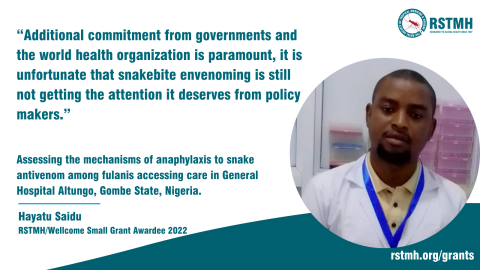
In Nigeria, at least 47% of the 213 million population live in rural settlements. This predominantly agrarian population is at an increased risk of snakebite envenoming. The consequences of snakebite envenoming are debilitating, often leading to disability and death. The uniqueness of rural communities as it relates to cultural beliefs and lack of easy access to healthcare facilities capable of handling snakebite envenoming, promote the devastation caused by snakebite envenoming.
Multifaceted commitment is fundamental in addressing this challenge. Researches aimed at improving and introduction of new preventive measures including ecological, zoological, and agricultural methods have to be promoted. Biomedical, clinical and social science researches for both management and prevention of snakebite envenoming are sorely needed.
Additional commitment from governments and the world health organization is paramount, it is unfortunate that snakebite envenoming is still not getting the attention it deserves from policy makers. This will go along way in providing the needed interventions, in form of antivenom and other logistics. Government and policy makers commitment will also pave way for translational and innovative researches in the area.
Why have you chosen your area of research?
Though snake antivenom is the mainstay therapy for snakebite envenoming, yet early adverse reactions are common. Such reactions can at times be more severe than the envenoming itself. To avert this crisis, collaboration among healthcare workers, researchers, governments, donor organizations and the community becomes necessary.
By joint commitment to research, training and policy implementation, early adverse reactions to snake antivenoms can quickly be identified and managed, if not prevented. This will pave the way towards the safe use of snake antivenoms
Sunil Koirala
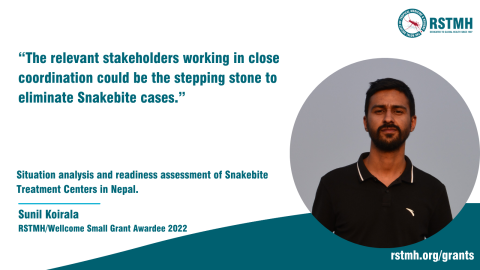
Snakebite management requires many sectors working together, only treating the snakebite cases will never be enough to minimize disabilities and deaths. It requires the health sector to unite together with agriculture, education, human resource management, supply chain management, recording and reporting systems to work together. The relevant stakeholders working in close coordination could be the stepping stone to eliminate Snakebite cases. Appropriate financing is vital to act and implement.
Why have you chosen your area of research?
A news article that reported the death of two siblings due to snakebite triggered my interest in this research area. Survival of the cases completely depends on the appropriate first aid measures followed by treatment with Anti Snake Venom Serum (ASVS) along with supportive care and management of complications. Although dedicated treatment centers have been established, snakebite fatalities and deaths have been increasing. Situation of the treatment centers are not known in terms of how they are functioning and providing their services in Nepal. Hence, I have chosen the area of research ‘Situation analysis and readiness assessment of Snakebite Treatment Centers in Nepal’.
Abiodun Wahab

'Being World NTD Day, we come together to advocate to our global leaders. We collectively ACT to ELIMINATE every vestige of Neglected Tropical Diseases (NTDs). Our emphasis is on coordinated action, addressing NTDs comprehensively through collaborative efforts. Let's facilitate a meaningful dialogue amongst communities, researchers, and policymakers to promote awareness and foster a deeper understanding. Through integrated one health approach, our goal is to ELIMINATE schistosomiasis and other NTDs by unraveling interconnected factors affecting its transmission and implementing effective strategies. Through the concerted efforts of acting, asking, and eliminating, we pave the way for a healthier future, breaking the cycles of schistosomiasis and advancing the global agenda to combat neglected tropical diseases.
Juliana Amanyi-Enegela
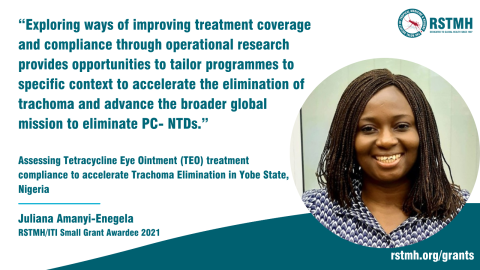
As we unite to address the challenges posed by NTDs, exploring ways of improving treatment coverage and compliance through operational research provides opportunities to tailor programmes to specific context to accelerate the elimination of trachoma and advance the broader global mission to eliminate PC- NTDs.
Edmund w. Kanmiki
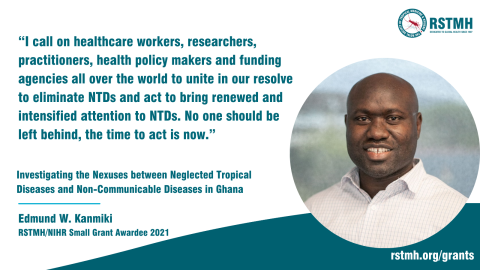
Global and regional efforts have contributed to progress in eliminating some Neglected Tropical Diseases (NTDs) and reducing the prevalence of others. Despite this, inadequate resource allocation and lack of concerted efforts have challenged progress aimed toward the elimination and control of NTDs in most developing countries. The enormous task of eliminating NTDs cannot be achieved through fragmented efforts, nonchalance, or lack of concerted approach. On this year’s World NTD Day, I wish to add my voice to the call for a united front in our efforts to eliminate and control NTDs. I call on healthcare workers, researchers, practitioners, health policy makers and funding agencies all over the world to unite in our resolve to eliminate NTDs and act to bring renewed and intensified attention to NTDs. No one should be left behind, the time to act is now.
Why have you chosen your area of research?
Neglected Tropical Diseases such as Lymphatic filariasis, Trachoma, Schistosomiasis, Onchocerciasis (river blindness) among others are still highly prevalent in most developing countries especially in sub-Saharan Africa and Southeast Asia. Unfortunately, the epidemiological transition over the last few decades has also led to rapid growth in the prevalence of non-communicable diseases such as stroke, high blood pressure, cancers, diabetes, and mental health disorders among others in these countries primarily due to changing patterns in lifestyles, urbanisation and aging population.
The high double burden of these disease conditions has worsened the already weak and under resourced healthcare systems and compounded the health and wellbeing challenges in these countries. Unfortunately, there is a paucity of context specific research evidence from these settings to help develop and implement targeted interventions to address these problems. I chose to study the nexuses between NDTS and non-communicable diseases (NTDs) in Ghana because, I believe an intricate understanding of the dual burden challenges of NTDs and NCDs as well as their combined effect on the health and wellbeing, is required to help in the development of effective integrated interventions for strengthening health systems, population health programs and policies. In addition, I believe advocacy for resource allocation is imperative for concerted efforts aimed at the elimination of NTDs and reducing the prevalence of NCDs in line with the UN Sustainable Development Goals.
Manase Kilonzi

I’m working with Muhimbili University of Health and Allied Sciences (MUHAS) a medical university in Tanzania. Tanzania is one of the endemic regions of infectious diseases including Malaria and Schistosomiasis. In line with SDG goal number 3 of promoting health and well-being of all people, MUHAS has a vision of conducting research and consultancy aiming to bring solution to various health-related challenges. I and my group we focus on assessing efficacy and safety of various medications approved for management of infectious diseases in low-middle income countries. In line with our goal, we have built interest in assessing efficacy and safety of praziquantel (PZQ) when used to treat schistosomiasis in pregnant women. However, we have realized that, few pregnant women are given PZQ despite residing in schistosomiasis endemic regions. Most of the schistosomiasis mass drug administration campaign aiming to eliminate schistosomiaasis exclude pregnant women from the program although guideline recommend the population to use PZQ. Therefore, our project aims to assess factors which influence utilization of PZQ in treatment and prevention of maternal schistosomiasis in Lake zone Tanzania.
Demise Mulugeta
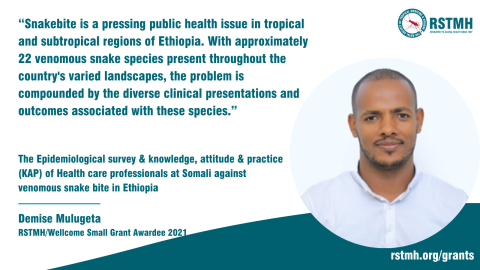
To have Healthy environment and community, working together on NTD elimination
The main reason that I have been focus Epidemiological survey and knowledge, Attitude and practice of health care professionals at Somali against venomous snake bite in Ethiopia is:
Snakebite is a pressing public health issue in tropical and subtropical regions of Ethiopia. With approximately 22 venomous snake species present throughout the country's varied landscapes, the problem is compounded by the diverse clinical presentations and outcomes associated with these species. Adding to the challenge is the limited accessibility to anti-venom in the country, which significantly impacts treatment outcomes. Furthermore, health facilities often provide inadequate care to individuals suffering from snakebites. Additionally there is no more data/ research finding that thin out the KAPs of health care professionals against treatments snakebite and snakebite epidemiology. I believe that generating data/evidence that show snakebite significance in the country and inadequate snakebite victim’s treatment gives a clues healthcare sector, policymakers, and communities alike to understand the current state of healthcare practices and provide valuable insights into the prevention and treatment of snake bites. By analyzing the data generated from these surveys, we can identify the gaps in awareness and treatment and develop strategies to improve the healthcare response to snake bites in the region and to come up with the direction of prioritizing the availability of anti-venom and improving healthcare delivery.
Viviane Mushi

Unite, Act, Eliminate encapsulates the collective effort required to break the cycle of urogenital schistosomiasis in Lindi, Tanzania. By fostering collaboration, taking decisive actions, and prioritizing water, sanitation, and hygiene, we can address the persistent transmission of this disease. Together, we strive to eliminate the barriers that perpetuate its spread, forging a path towards a healthier and more resilient community.
Why have you chosen your area of research?
Choosing to delve into the influence of water, sanitation, and hygiene on the persistent transmission of urogenital schistosomiasis among preschoolers and school-age children in Lindi, Tanzania was motivated by the urgency to address a critical public health issue. During this period, I sought to unravel the intricate connections between environmental conditions and the prevalence of urogenital schistosomiasis, with a focus on vulnerable age groups. The research aimed to generate timely insights that could inform targeted interventions, contributing to the ongoing global efforts to eliminate schistosomiasis and safeguard the health of young populations in Lindi and beyond.
Elias Mwakilama
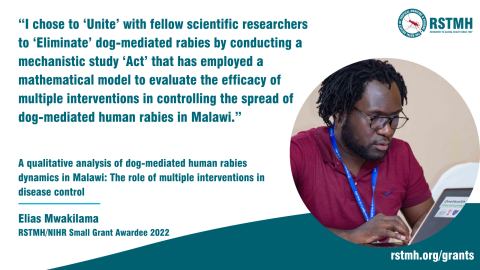
Neglected tropical diseases (NTDs) such as dog-mediated rabies remain a burden to most economically disadvantaged countries in sub-Saharan Africa (SSA), including Malawi. Despite being completely preventable in the humans, research cites failure to implement well-defined control measures (e.g., intensive public awareness, well-coordinated disease surveillance and diagnostics systems, dog vaccinations and PEP) for humans in endemic areas ignites the deadly disease to continue to disproportionately affect rural communities, particularly children.
Why have you chosen your area of research?
Although improved rabies surveillance or diagnostic systems and educating campaigns are widely advocated for to curb rabies globally, lack of secondary interventions such as homeopathic or pre-or PEP remedies in SSA to reduce chances of infection after human exposure leaves mass dog vaccination as the only option for African states. However, research suggests that efficacy of mass dog vaccination, combined with secondary interventions needs to be characterized further so as to provide relevant information for understanding disease dynamics and the development of policy measures. Thus, in line with the #WorldNTDDay theme, I chose to ‘Unite’ with fellow scientific researchers to ‘Eliminate’ dog-mediated rabies by conducting a mechanistic study ‘Act’ that has employed a mathematical model to evaluate the efficacy of multiple interventions in controlling the spread of dog-mediated human rabies in Malawi.
Lazaaro Mujumbusi

In the context of persistent Schistosomiasis transmission in the rural fishing community of Bugoto landing site, Mayuge District, Uganda, the theme 'Unite, Act, Eliminate' resonates deeply. In this project I am uniting the community to act through comprehensive health education by bringing them together to discuss about schistosomiasis in the community context, I do not only bring community members but their leaders too. The community and its leaders have been using the local word ‘ekidada’ to refer to bilharzia, yet some members in the community think ‘ekidada’ is caused by witchcraft, bringing all of them together has enabled all members to agree on referring to bilharzia as bilharzia because the local word ‘ekidada’ confuses them, through the community meetings, the leaders have suggested coming up with bylaws towards open defecation in the community. This highlights how the community has united to act on the elimination of schistosomiasis. This project embodies a collective effort to combat Schistosomiasis. The theme highlights the importance of collaboration, proactive measures, and a shared commitment to eliminating the burden of this neglected tropical disease.
Why have you chosen your area of research?
The choice to implement a health education program in the rural fishing community of Bugoto landing site stems from the critical need to address the persistent transmission of Schistosomiasis in an area where it has been largely neglected as neglected diseases are mainly diseases for poverty-stricken communities like Bugoto. The prevalence of the disease is exacerbated by poor sanitation and mixed knowledge about schistosomiasis. From research conducted in this community by the Lamberton lab group at the University of Glasgow, we found a lot of misperceptions about schistosomiasis, especially interpreting some symptoms of schistosomiasis like a swollen stomach as a symptom of being bewitched, in addition, we found a lot of confusion regarding the local name of bilharzia with some including the community leaders referring to bilharzia as ‘ekidada’ yet to them ‘ekidada’ was caused by witchcraft, in this program we have brought the community members together with the leaders and agreed to always refer to bilharzia as bilharzia to avoid confusion of ‘ekidada’. Another misperception leading to this project was people thinking they get schistosomiasis by drinking lake water and they would do other risky activities like swimming, washing and bathing in the lake thinking the risk is drinking lake water (Mujumbusi et al 2023, Ssali et al 2021).
Secondly, in Uganda, the available education program is not tailored to the community needs which leaves affected communities with inadequate knowledge about Schistosomiasis prevention, transmission, and treatment. In addition, schistosomiasis is not included in the Uganda national treatment program, therefore, I choose this education program to remind and inform people to always take drugs when available during MDA.
Thirdly, in our findings (Mujumbusi et al 2023), we found some people who do not like praziquantel because of the side effects, in this study, I wanted to explain to them why side effects happen and what they should do when they get side-effects.
The health education program is being done through community meetings with community members and their leaders, this brings them together to unite and act towards elimination of schistosomiasis in the community.
Overall, the multifaceted approach, including videos, plays, community meetings, training sessions, public radio broadcasts, and murals, seeks to drive behavioural change within the community. Overall, in this project I seek to empower the community with knowledge, fostering a proactive approach to Schistosomiasis control measures and contributing to the broader goal of eliminating this neglected tropical disease by engaging the community members in developing the education program.
Sandra Bushuyu

Thin skin and a body of pain or thick skin and a body of hope? “The children are crying”, it itches most in the night when we are alone, from the head to our toes. Imagine healing scabies and layering our body together, a thick skin and nothing less but hope. ‘Unite, Act, Eliminate.’
Why you have chosen your area of research?
Scabies is a major public health problem in many low-and middle-income countries and a significant cause of morbidity. In Hoima district, there is a high rate of scabies infections as about 1500 people were infected of which more children aged below 5 years (31.7%) and between 5 to 14 (28.7%) years were most affected according to the surveillance exercise conducted in 2022 and yet historically there is limited scabies research in Uganda. This is because for a long time skin diseases have been neglected therefore, the study aims at providing more information to trigger evidence based interventions and decision making.
Maria Mgella Zinga

Female genital schistosomiasis is an infection of the parasite Schistosoma haematobium characterised by deposition of eggs in genital tract of women and girls in endemic areas.There is a lack of information among community members and health workers on the burden of the disease, disease presentation, management and prevention. It has been misdiagnosed as a sexually transmitted infection creating stigma among those affected. There is a need to use already available resources to combat this disease. The integration of HPV screen and FGS screening in endemic areas will help in early diagnosis and proper management of affected individuals which in turn may help to decrease the risk of acquiring HIV infection.
I hope through my work and collaboration with others we will bring awareness to this neglected disease and come up with innovative ideas to improve screening, diagnosis, management and prevention. Let us unite and act together, in swahili we say "Umoja ni nguvu, utengano ni udhaifu". Together we can achieve anything we put our minds on.
Esther Danquah
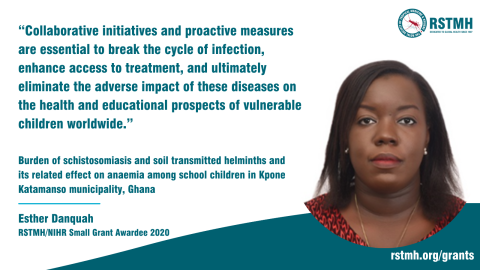
“Unite, Act, Eliminate" gains urgency in addressing the burden of schistosomiasis and soil helminths among school children, as these neglected tropical diseases contribute significantly to the prevalence of anemia. Collaborative initiatives and proactive measures are essential to break the cycle of infection, enhance access to treatment, and ultimately eliminate the adverse impact of these diseases on the health and educational prospects of vulnerable children worldwide.
Why have you chosen your area of research?
Conducting this study was crucial as it guides the implementation of successful intervention programs by assessing the prevalence of schistosomiasis and soil-transmitted helminth infections in the Kpone Katamanso Municipality. The focus stems from the pressing need to address neglected tropical diseases in vulnerable populations. Additionally, the research aimed to determine the impact of these Neglected Tropical Diseases as well infections on anemia, filling the knowledge gap in this area. The study's outcomes did not only inform stakeholders and policy makers but also contribute valuable insights into the association between schistosomiasis, soil-transmitted helminth infection, and school absenteeism among children in the Kpone Katamanso Municipality in Ghana. This specific area of research was chosen to contribute insights that can inform targeted interventions, alleviate the health disparities in the region, and empower communities through a nuanced understanding of the interplay between parasitic infections and anemia among school-going children.
Wathiqah Wahid

Collective efforts in dengue prevention are crucial. The most contributing action you can do is practice just 10 minutes weekly to search and destroy potential mosquito breeding sites, making a difference in the fight against dengue.
The selection of dengue as one of my research focus is driven by the persistent global prevalence of this disease. Empowering the public and communities is pivotal in achieving sustainable progress in eliminating infectious diseases, especially dengue.
Sarika Palepu

A multi-sectoral approach is imperative to address the challenges posed by scabies. Key stakeholders from the community, grass root level health workforce and trained medical professionals, should work in unison to raise awareness regarding the clinical manifestation of scabies and the potential adverse consequences if untreated. Disease elimination becomes feasible when community members act promptly to seek healthcare services and medical personnel effectively manage the condition. The integration of routine surveillance into the existing healthcare system is crucial for the successful elimination of this neglected tropical disease.
Why have you chosen your area of research?
Research on scabies in children under five years of age is scanty. Undertaking projects specifically targeting this age group would aid in estimating the disease prevalence, devising strategies for early control, preventing adverse outcomes, and ultimately working towards its elimination. Given the presence of a pre-existing health workforce at the grassroot level of healthcare delivery system in India, my project focused on efficiently mobilizing and repurposing their routine visits to actively identify scabies cases within the community
Michael Muhoozi

To 'Unite, Act, Eliminate' neglected tropical diseases like snakebite envenoming, we must improve health education, antivenom access, and data collection across borders and sectors. My research on the economic burden of snakebites in Uganda highlights the inequities when poor households suffer catastrophic health expenditures from this neglected health threat. Evidence on the true costs can guide united, decisive action for health equity.
I chose to estimate the economic burden of snakebites in Eastern Uganda because this neglected tropical disease disproportionately impacts poor, rural communities, yet remains overlooked. By quantifying the true costs of snakebite envenoming, my research aimed to spur action and investment to prevent snakebite-related morbidity and mortality in Uganda and beyond.
Joan Tusabe

To 'Unite, Act, Eliminate' snakebite morbidity and mortality, we must understand the complex socio-cultural factors influencing disease prevention and treatment. My research explored knowledge gaps, perceptions, and healthcare seeking behaviors for snakebites in rural Kamuli. Bridging the disconnect between communities and health systems is key to eliminating this neglected tropical disease.
Using participatory research appraisals, I chose to study community knowledge and behaviors for snakebite management in rural Uganda because treatment delays contribute to deaths and disability. By uncovering perceptions influencing healthcare choices after snakebite, my research provides insights to guide culturally-appropriate education and interventions. Together we can act to save lives from this neglected health threat."
Ana Garcia Mingo

I feel like the word UNITE is extremely relevant and appropriate for the skin NTD group, working on integration is the only way forward for remote and underserved populations and moreover for the areas of proctracted crisis and conflict.
Understanding the behaviour of scabies after cessation of ivermectin in a previous onchocerciasis focus has provided a beautiful example of how integration will be a key strategy for tackling skin NTDs in the future. Worldwide distributed scabies carries significant morbidity, and the results from our operational research aims to advocate for the reintroduction of ivermectin as MDA.
